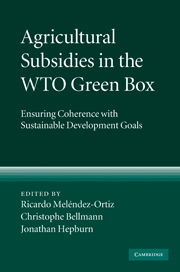Book contents
- Frontmatter
- Contents
- List of contributors
- Preface
- Acknowledgements
- List of abbreviations
- 1 Overview
- PART I The recent evolution of agricultural trade policy reform
- PART II The focus, extent and economic impact of green box subsidies
- PART III Green box subsidies and developing countries
- PART IV Green box subsidies and the environment
- PART V Looking forward: how can change take place?
- 19 Improving monitoring and surveillance of green box subsidies
- 20 EU subsidy reform: options for achieving change
- 21 Subsidy reform in the US context: deviating from decoupling
- 22 Agricultural trade policy reform in Japan: options for achieving change
- 23 Towards a green box subsidy regime that promotes sustainable development: strategies for achieving change
- Appendix: Text of Annex 2 of the WTO Agreement on Agriculture (“the green box”)
- Index
- References
21 - Subsidy reform in the US context: deviating from decoupling
from PART V - Looking forward: how can change take place?
Published online by Cambridge University Press: 03 May 2010
- Frontmatter
- Contents
- List of contributors
- Preface
- Acknowledgements
- List of abbreviations
- 1 Overview
- PART I The recent evolution of agricultural trade policy reform
- PART II The focus, extent and economic impact of green box subsidies
- PART III Green box subsidies and developing countries
- PART IV Green box subsidies and the environment
- PART V Looking forward: how can change take place?
- 19 Improving monitoring and surveillance of green box subsidies
- 20 EU subsidy reform: options for achieving change
- 21 Subsidy reform in the US context: deviating from decoupling
- 22 Agricultural trade policy reform in Japan: options for achieving change
- 23 Towards a green box subsidy regime that promotes sustainable development: strategies for achieving change
- Appendix: Text of Annex 2 of the WTO Agreement on Agriculture (“the green box”)
- Index
- References
Summary
Introduction
In 1983, a US senator and several aides were discussing ideas to reform US farm policy. At the time, high government support prices were interfering with the market and the government was accumulating stocks. The aides proposed deeply cutting support prices and substituting direct payments that were “decoupled” from prices and production. Around the same time, agricultural economists began to recognize that domestic agricultural policies had significant impacts on world markets. They started to distinguish between different types of agricultural policies and to measure the impact that these policies had on world markets. Payments that were decoupled from prices and production had smaller negative effects on world markets and on third country exporters.
These ideas were taken up by Uruguay Round negotiators when they classified different agricultural policies into amber, blue and green boxes. Negotiators were explicitly recognizing the work of these policy makers and economists: that some policies (which came to be known as amber and blue box) had a bigger impact on global trade than others, and that these policies should rightly be disciplined by the World Trade Organization (WTO). They also recognized that some policies (now known as green box measures) had less impact on world trade and should be exempt from WTO disciplines. They were implicitly hoping to drive US and EU policies away from amber and blue box subsidies into green box subsidies.
- Type
- Chapter
- Information
- Agricultural Subsidies in the WTO Green BoxEnsuring Coherence with Sustainable Development Goals, pp. 604 - 617Publisher: Cambridge University PressPrint publication year: 2009

